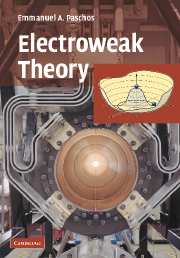Book contents
- Frontmatter
- Contents
- Preface
- Part I The road to unification
- 1 The electromagnetic current and its properties
- 2 The weak currents
- 3 The quark model
- Part II Field theories with global or local symmetries
- Part III Experimental consequences and comparisons
- Epilogue
- Appendix A Conventions, spinors, and currents
- Appendix B Cross sections and traces
- Appendix C Identities for quark bilinears
- Index
3 - The quark model
Published online by Cambridge University Press: 03 December 2009
- Frontmatter
- Contents
- Preface
- Part I The road to unification
- 1 The electromagnetic current and its properties
- 2 The weak currents
- 3 The quark model
- Part II Field theories with global or local symmetries
- Part III Experimental consequences and comparisons
- Epilogue
- Appendix A Conventions, spinors, and currents
- Appendix B Cross sections and traces
- Appendix C Identities for quark bilinears
- Index
Summary
Introduction
The quark model arose from the analysis of symmetry patterns observed when particles were grouped together according to their spin and parity. When the eight mesons with Jp = 0- are displayed in a strangeness (S) versus isospin (I3) plane, they form the octet of Fig. 3.1. An identical pattern emerges for the eight vector mesons with Jp = 1- also shown in Fig. 3.1. The vector mesons are excited states of the particles in the Jp = 0- octet. The symmetry pattern was interpreted as a generalization of the isospin group SU(2) to the group SU(3) which incorporates both isospin and strangeness. Gell-Mann and Neeman (1964) proposed that the eight baryons with Jp = ½+ also belong to an octet of SU(3), thus establishing a parallelism between meson and baryon states. Finally, many static properties of the particles exhibit the SU(3) symmetry.
Since the fundamental representation of the group SU(3) is a triplet, it is natural to try to interpret the hadronic states in the octets as bound states of triplets or of triplets with antitriplets. If the fundamental fields also carry baryon number, the product of triplet ⊗ antitriplet would be mesons with zero baryon number. The product of three triplets carries baryon number and contain octets and a decuplet as was required by the observed states of baryons. This is the quark model of Gell-Mann (1964) and Zweig (1964).
Information
- Type
- Chapter
- Information
- Electroweak Theory , pp. 21 - 30Publisher: Cambridge University PressPrint publication year: 2007
